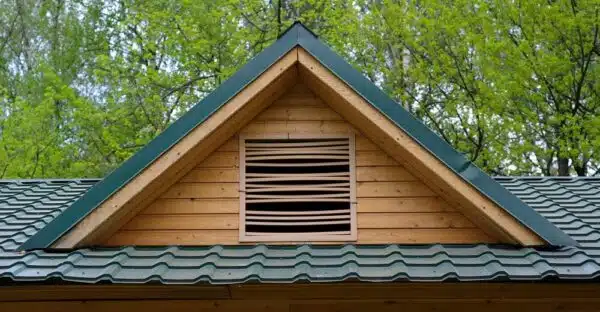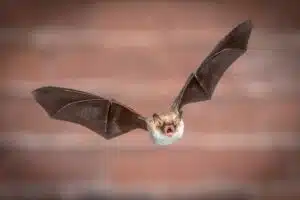How to Identify and Prevent Bats in the Attic
By : Rita Stadler
Not long ago, I wrote a story called “What’s In Your Attic,” where I talked about how to detect a troublemaker squirrel in your attic — before he becomes a long-term tenant. We got such a great response that we decided to take a closer look at some of the other uninvited guests you told us you’d like to evict from this area in your home.
Our customers spoke, and we’re listening — here’s what to do when bats are driving you batty.
How Do Bats Get Into Your House
Bats find their way into houses through holes, cracks, and openings that are large enough for them to pass through. A bat infestation in your attic poses a big threat and can be one of the most difficult types of wildlife to remove. Often they travel solo — in search of a safe, warm place where a female bat can give birth. Females can only have one baby a year, they’d prefer to do this in an undisturbed area.
In a location like your attic, a single or a small family of bats can go unnoticed for a while, making this the perfect roosting spot. If you live in a cold climate, they’ll often leave for the winter — when they go in search of a 35-40 degree hibernation spot. But they’ll likely find their way back when the heat begins to rise — and remarkably, they’ll remember exactly how to get to your house because of their inbuilt magnetic compasses.
How to Identify a Bat Problem
Due to the multiplication of bats over time, they could start to form a colony of bats in your space. If this happens, you’ll start to notice them flying around the outside of your house and you’ll hear noises in your attic.
While the squeaks and scratching sounds that they make at dusk can make you feel like you’re living in a house of horrors, those noises should actually be the least of your worries. Bats left unattended can cause damage to your attic and to your health.
Damage They Can Cause
Not only will bats cause damage to insulation, wiring, and walls from chewing — but they also leave behind foul-smelling excrement called guano. These droppings pile up very quickly and can potentially cave in your ceiling under their weight.
Bat feces also carry an airborne fungus that can cause a disease in humans called Histoplasmosis, which can result in chronic lung disease. If left untreated, it can be fatal. But, the most important public health risk associated with bats is rabies. It has been found in all 40 species of bats in the United States and most of Canada.
How to Get Rid of Bats in Your Attic
 The first step in getting rid of this type of pest infestation is to locate their entry points. There is no need to pull out your Louisville Slugger and try to out-bat a real bat. They are not after your blood, and it is illegal to kill bats in the United States and all of Europe.
The first step in getting rid of this type of pest infestation is to locate their entry points. There is no need to pull out your Louisville Slugger and try to out-bat a real bat. They are not after your blood, and it is illegal to kill bats in the United States and all of Europe.
For this type of pest problem, an exterminator should be your first call. Exterminators will help find the holes or cracks in your house that the bats use as their doorway. They will patch up any openings that may lead to your living spaces from the attic so these pests don’t decide to cozy up in your curtains.
There are several different ways in which a professional wildlife removal expert can go about addressing entries in the home, but the most common is to use the existing hole and turn it into a one-way opening where the bat’s only option is to go back out. This is called bat exclusion. The process is tricky, and time-consuming, and is done at night when the pests are out feeding on insects. There are also certain times of the year when exclusion is not allowed because there are species of bats that are protected and who may have had babies in your home. Removing mothers from a home would strand the babies, which is against the law.
Other methods used for bat removal are trapping, repelling, and using bright lights and loud noises. Trapping is the only form of removal that has been proven to work for an extended period of time.
How to Avoid Future Infestations
There is only one thing that you can do to keep bats from roosting in your home –and that’s to seal or fix the holes. These pests can fit into an opening that’s 3/8 of an inch wide and most commonly they find their entrances in chimneys, vents, soffits, and under roofing and siding. Holes can be sealed with wire mesh screening and adhesive or caulking. The screen will keep these predators out of your house, and the adhesive and/or caulking will keep it dry and in place.
Being a homeowner or looking after a property can be a full-time job with all of the extra maintenance it requires. When it comes to a bat problem, it’s good to understand that these pests will choose a house based on food and water supply. Bright lights that attract bugs, such as porch and street lights, also attract bats. If you have a pool or a body of water by your house, they will use that to drink from.
Many of these scenarios aren’t in our control and can be frustrating. Thankfully, EarthKind is working hard to offer ideas and products that help with pest control naturally. Ridding your home and properties of unwanted guests in a safe and natural way is our number one goal. Stay tuned for more earth-friendly pest advice from EarthKind.
Keep your home pest free with simple, effective solutions. Subscribe and save!







 day
day